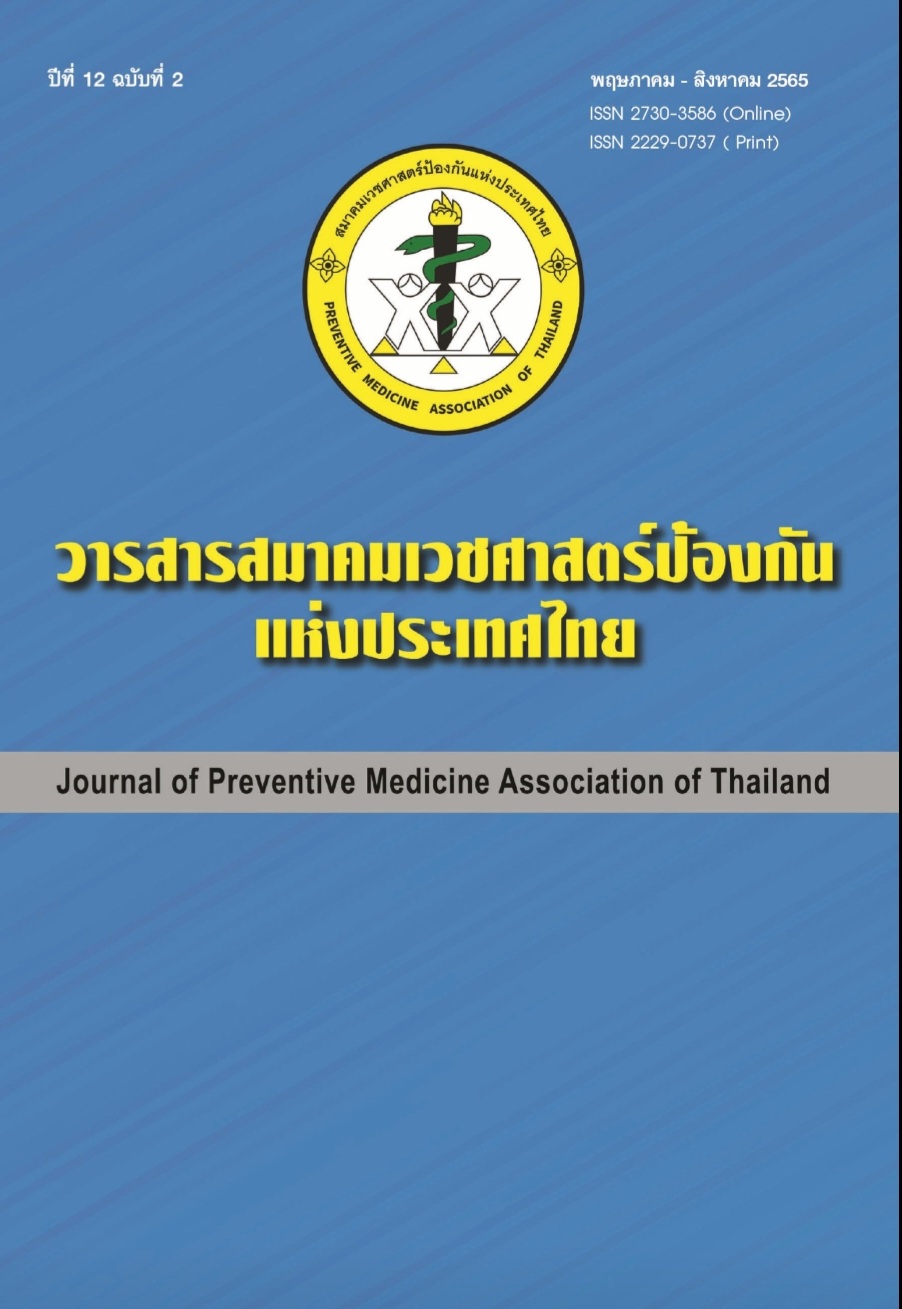Development of an Anemia Prevention and Solution Program in Pediatric 6–12 Months of Age in Prankratai Hospital Prankratai District, Kamphaeng Phet Province
Keywords:
Anemia, Program, Children 6–12 monthsAbstract
Children are the important human resources of the nation. However, the child developmental situation and intelligence level of Thai children tend to decrease due to iron deficiency. This a quasi–experimental research aims to study prevalence rate, related factors, development and trial of iron deficiency anemia prevention and treatment program as well as problems and obstacles in preventing and solving anemia problems in children aged 6–12 months who receive at the well’s baby clinic, Prankratai Hospital, during February–November 2020. Study the data from the medical record and interview form. Data were analyzed by descriptive statistics (frequency, percentage, mean, standard deviation), Chi–square test, Odds ratio, Paired–samples T test with a significance level of 0.05 and content analysis. The results found that: The sample of 248 people, males (54.8%), average age 8.72 months, the anemia prevalence rate (Hb<11g/dL) was 35.9%. The majority of primary caregivers are fathers or mothers, aged 30–50, higher secondary education/vocational, agriculture, family income 10,001–30,000 baht/month. Factors that were statistically related and risk factor for anemia in children were age 6–8 months (OR = 2.398; p = 0.001), birth weight less than 2500 grams (OR = 4.058; p<0.001), breastfed and formula feeding (OR = 26.527; p<0.001), weight unmatched (OR = 1.854; p = 0.021), disproportionate nutrition (OR = 2.733; p<0.001), with underlying/common disease (OR = 4.335; p<0.001), MCV <80 fl (OR = 1.434; p = 0.024), neutropenia and small size (OR = 2.041; p = 0.016), primary caregiver graduated from primary school (OR = 3.082; p = 0.001) and the family earns less than 10,000 baht/month (OR = 3.082; p<0.001). After participating in the program, the children had Hb>11g/dL(94.4%), it was also found that the automatic blood count (CBC) after joining the program were higher than before (p<0.05). The main problems and obstacles in the implementation were 1) not taking medicines as recommended by the doctor 2) not eating all 3 meals and groups 3) participating in the program not due to have to move with the family due to poverty. Based on the findings, anemia is a common problem in children, Therefore, it is necessary to implement an effective prevention and treatment program for iron deficiency anemia, and follow–up these children to know the factors associated with the occurrence of anemia in the end.
References
จินตนา พัฒนพงศ์ธร, ประภาภรณ์ จังพาณิช, อาริสรา ทองเหม, บรรณาธิการ. คู่มือปฏิบัติการคลินิกสุขภาพเด็กดี. พิมพ์ครั้งที่ 2. นนทบุรี: กรมอนามัย กระทรวงสาธารณสุข; 2557.
สุจิตรา บางสมบุญ, ชัยวัฒน์ อภิวันทนา, พรทิพย์ รักคำมี. ความชุกและปัจจัยที่เกี่ยวข้องกับภาวะโลหิตจางจากการขาดธาตุเหล็กในทารกอายุ 6 เดือนที่โรงพยาบาลส่งเสริมสุขภาพ ศูนย์อนามัยที่ 3. โรงพยาบาลส่งเสริมสุขภาพ ศูนย์อนามัยที่ 3 นครสวรรค์. วารสารการพยาบาล การสาธารณสุขและการศึกษา 2561;19(1):40-8.
อรัญญา ปีกเกษม. ความชุกของภาวะขาดธาตุเหล็กในทารกอายุ 6 เดือนที่เลี้ยงด้วยนมแม่. [อินเทอร์เน็ต]. 2555 [เข้าถึงเมื่อ 31 มี.ค.2563] เข้าถึงได้จาก: http://www.thaipediatrics.org/html/slidedetail2_news.php?journal_id=176.
โครงการประเมินเทคโนโลยีและนโยบายด้านสุขภาพ. โครงการพัฒนาข้อเสนอเพื่อการปรับปรุงชุดสิทธิประโยชน์และระบบบริการด้านการสร้างเสริม สุขภาพและป้องกันโรค สำหรับปีงบประมาณ 2559 ภายใต้ระบบหลักประกันสุขภาพถ้วนหน้า : ร่างมาตรฐานการทำงาน การป้องกันโลหิตจางในเด็ก [อินเทอร์เน็ต]. 2559 [เข้าถึงเมื่อ 31 มี.ค.2563]. เข้าถึงได้จาก: https://www.hitap.net/wp-content/uploads/2014/12/QS-animia.pdf
สำนักโภชนาการ กรมอนามัย. คู่มือแนวทางการควบคุมและป้องกันโลหิตจางจากการขาดธาตุเหล็ก. คณะกรรมการควบคุมและป้องกันโลหิตจางจากการขาดธาตุเหล็ก. นนทบุรี: สำนักโภชนาการกรม อนามัย กระทรวงสาธารณสุข; 2558.
วีณา มงคลพร. สถานการณ์และผลการรักษาภาวะโลหิตจางในคลินิกสุขภาพเด็กดี โรงพยาบาลส่งเสริมสุขภาพ ศูนย์อนามัยที่ 5 นครราชสีมา. วารสารศูนย์อนามัยที่ 5 นครราชสีมา 2556;7(15):18–35.
ศรัชฌา กาญจนสิงห์. โลหิตจางจากการขาดธาตุเหล็กในเด็กทารก...อันตรายจริงหรือ ?[อินเทอร์เน็ต]. 2558 [เข้าถึงเมื่อ 30 มี.ค.2563]. เข้าถึงได้จาก: https://srushcat.files.wordpress.com/2015/07/anemia.pdf.
อรรถสิทธิ์ แดงมณี. ความสัมพันธ์ของภาวะซีดในทารกกับการกินนมแม่อย่างเดียว 6 เดือน. กลุ่มงานกุมารเวชกรรม โรงพยาบาลพัทลุง จังหวัดพัทลุง. วารสารวิชาการแพทย์เขต 11 2561;32:821–30.
นงค์นุช สุขยานุดิษฐ. ความชุกและปัจจัยเสี่ยงต่อภาวะโลหิตจางจากการขาดธาตุเหล็กในเด็กอายุ 6–12 เดือนโรงพยาบาลท่าตูม จังหวัดสุรินทร์. วารสารอุบลเวชสาร 2561;1:10–20.
จตุพร ดวงเพชรแสง. ภาวะโลหิตจางในเด็กอายุ 6–12 เดือนที่มารับบริการคลินิกสุขภาพเด็กดี โรงพยาบาลแก้งคร้อ. ชัยภูมิเวชสาร 2560;37(2):30-9.
ยอดขวัญ อภิกุลชาติกิจ. ความชุกของภาวะโลหิตจางและประสิทธิผลของการป้องกันโลหิตจางในทารกอายุ 9–12 เดือน ที่มารับบริการในคลินิกสุขภาพเด็กดี โรงพยาบาลตำรวจ. วารสารพยาบาลตำรวจ 2563;12(1):161-70.
อรุณี เจตศรีสุภาพ. โลหิตจางจากขาดธาตุเหล็ก (Iron deficiency anemia). [อินเทอร์เน็ต]. 2558 [เข้าถึงเมื่อ 31 มี.ค.2563]. เข้าถึงได้จาก: http://haamor.com/th/
Downloads
Published
How to Cite
Issue
Section
License
Copyright (c) 2022 Journal of Preventive Medicine Association of Thailand

This work is licensed under a Creative Commons Attribution-NonCommercial-NoDerivatives 4.0 International License.
บทความที่ลงพิมพ์ในวารสารเวชศาสตร์ป้องกันแห่งประเทศไทย ถือเป็นผลงานวิชาการ งานวิจัย วิเคราะห์ วิจารณ์ เป็นความเห็นส่วนตัวของผู้นิพนธ์ กองบรรณาธิการไม่จำเป็นต้องเห็นด้วยเสมอไปและผู้นิพนธ์จะต้องรับผิดชอบต่อบทความของตนเอง






